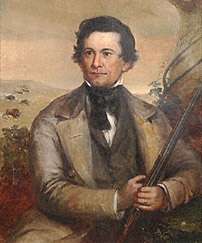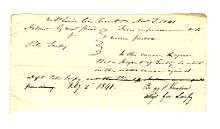Peter A. Sarpy
| Peter Abadie Sarpy | |
|---|---|
 | |
| Born |
November 3, 1805 St. Louis, Missouri |
| Died |
January 4, 1865 Plattsmouth, Nebraska |
| Occupation | Fur trader |
| Known for | Civic activities |
Peter Abadie Sarpy (1805–1865) was the French-American owner and operator of several fur trading posts, essential to the development of the Nebraska Territory, and a thriving ferry business. A prominent businessman, he helped lay out the towns of Bellevue and Decatur, Nebraska. Nebraska's legislature named Sarpy County after him in honor of his service to the state.
Biography
Peter A. Sarpy was likely born in St. Louis, Missouri on November 3, 1805. He was christened Pierre Sylvester Gregoire Sarpy, but he later anglicized his name and took his mother's maiden name, L'Abadie for his middle initial.[1] Peter's father was Gregoire Sarpy, who died in 1824. Peter had two brothers.[2] The family was French Creole, and joined other ethnic French in migrating to the growing town of St. Louis after the Louisiana Purchase by the United States. Its lucrative fur trade and much of the economy was originally dominated by ethnic French families.
Nebraska Territory
In 1824 at the age of 19, Sarpy went to the upper Missouri River, in the Nebraska Territory, to work at the American Fur Company's trading post at Council Bluff, north of present-day Bellevue, Nebraska. He was based at Fort Bellevue until 1831.[1] That company was owned by renowned fur baron John Jacob Astor. Sarpy next worked for his brother's father-in-law, John Pierre Cabanné, who ran Cabanne's Trading Post.[3]
Cabanné's Post and Pilcher's Post, the latter established at Bellevue by the Missouri Fur Company, competed for the fur trade of area Indian tribes: the Siouan-speaking Omaha, Ponca, Otoe, and Pawnee. The Missouri Fur Company was founded by French Creole families in St. Louis. Some of their ancestors had migrated to the new settlement of St. Louis in the late eighteenth century from farms in Illinois. They left when the latter was transferred from French to British control after the Seven Years' War. More migrated after the American Revolution, as they wanted to evade US Protestant rule in Illinois.
The fur trade in the region yielded such profits that for decades it was the most important driver of the St. Louis economy. In 1821 it represented $600,000 of the town's annual commerce of $2 million.[4]
Sarpy later established a trading post and supply point for white settlers and pioneers on the Iowa side of the upper Missouri River. It went by various names, including Sarpy's Point and the "Trader's Post".[5][6]
In 1832 Cabanné ordered Sarpy to head a group of American Fur Company employees to take over a keelboat and goods which belonged to a competing company. Because of its profits, the fur trade business had cutthroat competition. After they were caught, US authorities ordered Cabanné and Sarpy to leave the Indian Territory for a year. The company replaced Cabanné with Joshua Pilcher at Cabanné's Trading Post in North Omaha.[7] Sarpy operated the Council Bluff trading post during 1835.
Colorado
Sarpy moved westward the next year, and in 1837 he established Fort Jackson on the upper South Platte River in present-day Colorado. Financed by Pratt, Chouteau, and Company, Sarpy established the fort with the help of Henry Fraeb, an experienced trapper and former Rocky Mountain Fur Company man. At Fort Jackson, the two traded tin ware, traps, clothes, blankets, powder, lead, and whiskey for pelts. Sarpy did well at this trading post, maintaining an inventory of $12,000 and paying his employees $200 a year. Another firm, Bent, St. Vrain & Company bought out Fort Jackson to avoid competing with them. After the sale, Sarpy cut ties with Fraeb. Fraeb was killed by Sioux Indians on the Snake River in 1850.[1]
Missouri

At some point, Sarpy returned to St. Louis and owned at least one slave, known as Andrew. Andrew's mother, Celeste, helped her son to bring suit against Sarpy for his freedom in 1839. Andrew alleged trespass and false imprisonment. Apparently members of Andrew's family were pronounced free by a verdict of the circuit court of St. Louise and St Charles county. Andrew also said that Sarpy beat and mistreated him and most importantly, held him as a slave although he was a free person. The suit asked for damages of $200 and Andrew's freedom. Sarpy plead no guilty to these charges, but was found guilty in court on February 2, 1841.[8]
Returning to Nebraska
In 1838, Sarpy returned to the Bellevue area and built another trading post. He stayed at Fort Bellevue for the next twenty-six years.[1] After Sarpy returned, he became influential in community affairs. About 1846 Sarpy started a ferry business across the Missouri, between Bellevue and the Iowa side. Through the next year, he ferried Mormons across the river and supplied them for the rest of their westward trip. During the ensuing gold rush years, Sarpy's ferry boats hauled many of the would-be gold miners across the Missouri River.[9] Sarpy expanded his ferry business in two other locations: to cross the Elkhorn River at Elkhorn City, later called Elk City, and also at a fork of the Loup River near present-day Columbus. By the 1850s, his fleet included a steam ferry.[10]
Through his efforts, in 1849 an area post office, mark of a rising town, was established in Bellevue. Following the United States' negotiation in 1854 of a treaty by which the Omaha people ceded their land in Nebraska, that year Sarpy was among the group that laid out the town of Bellevue. In 1857 Sarpy joined Stephen Decatur and others in founding Decatur along the Missouri in northeastern Burt County.[11][12]
Sarpy and his family moved to Plattsmouth in 1862. He died there on January 4, 1865. He is buried in Calvary Cemetery in St. Louis, Missouri.
Marriage and family
Sarpy married Ni-co-mi (also spelled Ni-co-ma), of the Iowa people. She brought her daughter Mary Gale to the marriage. Ni-co-mi had been the consort of the American surgeon John Gale, who had been stationed at Fort Atkinson. When it was closed in 1827 and he was reassigned, Gale left Ni-co-mi and Mary behind.[13] Sarpy and Ni-co-mi also had children together.
As an adult, Mary Gale (also known as Hinnuaganun, or One Woman) married Joseph LaFlesche, a Métis fur trader of Ponca and French descent. Adopted as a son by the chief Big Elk and designated his successor, LaFlesche became the last recognized principal chief of the Omaha and the only one to have had any European ancestry.[14]
Honors and legacy
- Sarpy County was named in his honor.[12][15]
- Sarpy's Post was added to the National Register of Historic Places.
See also
References
- 1 2 3 4 Crutchfield, James A.; Moutlon, Candy; Del Bene, Terry (2015). The Settlement of America: An Encyclopedia of Westward Expansion from Jamestown to the Closing of the Frontier. New York: Routledge.
- ↑ Otto, William T. (1904). United States Reports, Supreme Court: Cases Argued and Adjudged in the Supreme Court of the United States, Volume 92. New York: Banks Law Publishing.
- ↑ Federal Writers Project. (1939) Nebraska: A Guide to the Cornhusker State, Nebraska State Historical Society, p. 267
- ↑ James Neal Primm, Lion of the Valley: St. Louis, Missouri, 1764-1980, St. Louis: St. Louis Historical Society Press, 3rd edition, 1998, p. 124
- ↑ "History of Sarpy County", Nebraska Association of County Officials. Retrieved 8/8/08.
- ↑ "The Early Ferries". Retrieved 8/8/08.
- ↑ "Nebraska National Register Sites in Sarpy County", Nebraska State Historical Society, Retrieved 8/8/08.
- ↑ Washington University in St. Louis. "Andrew, by and through his next friend, Celeste v. Peter Sarpy". St. Louis Circuit Court Records. Washington University in St. Louis. Retrieved July 28, 2016.
- ↑ "Peter Sarpy", NebraskaStudies.org. Retrieved 8/8/08.
- ↑ "Peter A. Sarpy", Retrieved 8/8/08
- ↑ "Peter Abadie Sarpy", Nebraska Social Studies Association, Retrieved 8/8/08.
- 1 2 "Bellevue - Sarpy County", University of Nebraska-Lincoln. Retrieved 8/8/08.
- ↑ Erin Pedigo, The Gifted Pen: the Journalism Career of Susette "Bright Eyes" La Flesche Tibbles, Master's Thesis, University of Nebraska Lincoln, April 2011, accessed 23 August 2011
- ↑ "Joseph La Flesche: Sketch of the Life of the Head Chief of the Omaha", first published in the (Bancroft, Nebraska) Journal; reprinted in The Friend, 1889, accessed 23 August 2011
- ↑ "Peter Abadie Sarpy", Nebraska Social Studies Association. Retrieved 8/8/08.
External links
- Historical image of Peter Sarpy.